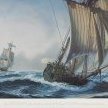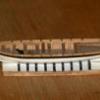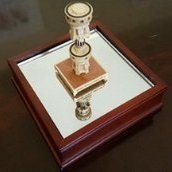Supplies of the Ship Modeler's Handbook are running out. Get your copy NOW before they are gone! Click on photo to order.
×
-
Posts
4,446 -
Joined
-
Last visited
Reputation Activity
-
 Landlubber Mike got a reaction from popeye the sailor in McDonnell Douglas F-4J Phantom II by Egilman - FINISHED - 1/32nd scale - PLASTIC - VF-154 off the USS Ranger
Landlubber Mike got a reaction from popeye the sailor in McDonnell Douglas F-4J Phantom II by Egilman - FINISHED - 1/32nd scale - PLASTIC - VF-154 off the USS Ranger
Wow, how did I miss this one?? What a fantastic build, amazing work! Mucho respect! Looking forward to your forthcoming builds!
-
 Landlubber Mike got a reaction from popeye the sailor in German Military Car Typ 170 V Tourenwagen by CDW - Master Box - 1:35 Scale - PLASTIC
Landlubber Mike got a reaction from popeye the sailor in German Military Car Typ 170 V Tourenwagen by CDW - Master Box - 1:35 Scale - PLASTIC
Really nice work Craig! Looking forward to your return to this project.
-
 Landlubber Mike got a reaction from lmagna in McDonnell Douglas F-4J Phantom II by Egilman - FINISHED - 1/32nd scale - PLASTIC - VF-154 off the USS Ranger
Landlubber Mike got a reaction from lmagna in McDonnell Douglas F-4J Phantom II by Egilman - FINISHED - 1/32nd scale - PLASTIC - VF-154 off the USS Ranger
I believe Zoukei Mura is coming out with a series of F-4s, if they haven't already.
*EDIT* ZM recently released the F-4 in 1/48, not 1/32.
-
 Landlubber Mike got a reaction from Edwardkenway in McDonnell Douglas F-4J Phantom II by Egilman - FINISHED - 1/32nd scale - PLASTIC - VF-154 off the USS Ranger
Landlubber Mike got a reaction from Edwardkenway in McDonnell Douglas F-4J Phantom II by Egilman - FINISHED - 1/32nd scale - PLASTIC - VF-154 off the USS Ranger
Wow, how did I miss this one?? What a fantastic build, amazing work! Mucho respect! Looking forward to your forthcoming builds!
-
 Landlubber Mike got a reaction from popeye the sailor in Prinz Eugen 1942 by CDW - FINISHED - Trumpeter - 1:700 Scale - PLASTIC
Landlubber Mike got a reaction from popeye the sailor in Prinz Eugen 1942 by CDW - FINISHED - Trumpeter - 1:700 Scale - PLASTIC
Great work on a really nice subject Craig. Fantastic! Can't believe I missed this one.
I don't want to bring up too many things from prior posts, but:
1. Some of the PE on my destroyer was so thin, you could breathe on it and it would bend. I'd say just do the best you can. If it works, great, if not, the detail is probably so small nobody will notice anyway.
2. On the acrylic primers, I was just PM'ing with Craig the other day. I was a big fan of Vallejo, and still am to some extent, but now that I've figured out airbrushing a little better, I think I'm going to be moving to paints/primers like Mr. Color/Mr Surfacer, Tamiya, etc. At least for bigger areas. I've gotten decent results thinning Vallejo a bit, but the annoying clogged airbrush gets frustrating. It's almost like you need to shoot lacquer thinner through the airbrush at the end of the session to ensure you have removed the invisible sticky remnants. I'm ok with the smells because I vent outside. For things like cockpit interiors and other small details, I'll probably stick with Vallejo for ease of use.
-
 Landlubber Mike got a reaction from popeye the sailor in McDonnell Douglas F-4J Phantom II by Egilman - FINISHED - 1/32nd scale - PLASTIC - VF-154 off the USS Ranger
Landlubber Mike got a reaction from popeye the sailor in McDonnell Douglas F-4J Phantom II by Egilman - FINISHED - 1/32nd scale - PLASTIC - VF-154 off the USS Ranger
I believe Zoukei Mura is coming out with a series of F-4s, if they haven't already.
*EDIT* ZM recently released the F-4 in 1/48, not 1/32.
-
 Landlubber Mike got a reaction from Edwardkenway in McDonnell Douglas F-4J Phantom II by Egilman - FINISHED - 1/32nd scale - PLASTIC - VF-154 off the USS Ranger
Landlubber Mike got a reaction from Edwardkenway in McDonnell Douglas F-4J Phantom II by Egilman - FINISHED - 1/32nd scale - PLASTIC - VF-154 off the USS Ranger
I believe Zoukei Mura is coming out with a series of F-4s, if they haven't already.
*EDIT* ZM recently released the F-4 in 1/48, not 1/32.
-
 Landlubber Mike got a reaction from Canute in McDonnell Douglas F-4J Phantom II by Egilman - FINISHED - 1/32nd scale - PLASTIC - VF-154 off the USS Ranger
Landlubber Mike got a reaction from Canute in McDonnell Douglas F-4J Phantom II by Egilman - FINISHED - 1/32nd scale - PLASTIC - VF-154 off the USS Ranger
I believe Zoukei Mura is coming out with a series of F-4s, if they haven't already.
*EDIT* ZM recently released the F-4 in 1/48, not 1/32.
-
 Landlubber Mike got a reaction from Old Collingwood in McDonnell Douglas F-4J Phantom II by Egilman - FINISHED - 1/32nd scale - PLASTIC - VF-154 off the USS Ranger
Landlubber Mike got a reaction from Old Collingwood in McDonnell Douglas F-4J Phantom II by Egilman - FINISHED - 1/32nd scale - PLASTIC - VF-154 off the USS Ranger
I believe Zoukei Mura is coming out with a series of F-4s, if they haven't already.
*EDIT* ZM recently released the F-4 in 1/48, not 1/32.
-
 Landlubber Mike reacted to Egilman in McDonnell Douglas F-4J Phantom II by Egilman - FINISHED - 1/32nd scale - PLASTIC - VF-154 off the USS Ranger
Landlubber Mike reacted to Egilman in McDonnell Douglas F-4J Phantom II by Egilman - FINISHED - 1/32nd scale - PLASTIC - VF-154 off the USS Ranger
Thanks Mike, seems like when I'm not really trying everyone thinks it's the bees knees....
It's much appreciated my friend....
-
 Landlubber Mike got a reaction from Egilman in McDonnell Douglas F-4J Phantom II by Egilman - FINISHED - 1/32nd scale - PLASTIC - VF-154 off the USS Ranger
Landlubber Mike got a reaction from Egilman in McDonnell Douglas F-4J Phantom II by Egilman - FINISHED - 1/32nd scale - PLASTIC - VF-154 off the USS Ranger
Wow, how did I miss this one?? What a fantastic build, amazing work! Mucho respect! Looking forward to your forthcoming builds!
-
 Landlubber Mike reacted to Ian Barefoot in 'Vallejo' v 'Admiralty' paint brands - your views appreciated
Landlubber Mike reacted to Ian Barefoot in 'Vallejo' v 'Admiralty' paint brands - your views appreciated
To all that responded to the thread - my thanks for the valid points raised. I've decided to take a 'middle road' and have ordered the 'Admiralty' paints for Sherbourne. My intention is then to prep some relevant woodstock and the paint it with a test sample of each brand with the colours as close as possible without actually touching!
With regard to paint formulae a funny(?) story with a moral...
As a nautical archaeologist I worked as a project officer for the Nautical Archaeology Society. We're based a 'Fort Cumberland' in Southsea which is a 'Scheduled Ancient Monuument' (the same level of protection as Stonehenge). The structures date back to the Napoleonic period. The front door to our office was peeling badly & we asked for permission to repaint it. 'Only if you use the correct formual paint' for the period' was the reply. Samples were sent for analysis, and £70:00 later we recieved a small tin of paint. We happily rubbed down the old paintwork and applied the new... It took six weeks to dry and another two weeks to peel.. We didn't have the same problem with the £7.50 tin of 'Valspar' which we painted over the top.....
Kindest Regards and once again - my thanks
Ian
-
 Landlubber Mike reacted to LyleK1 in CA residue problem
Landlubber Mike reacted to LyleK1 in CA residue problem
Just to add... Shellac will cover the wood and hide the CA glue completely. I used it recently on a build that used CA glue exclusively.
You cannot tell once the Shellac is applied:
-
 Landlubber Mike reacted to Bob Cleek in Priming Below the Waterline
Landlubber Mike reacted to Bob Cleek in Priming Below the Waterline
The distinction between primer and sanding undercoat is often overlooked. Primer is thin and soaks into the bare wood surface. It can be thinned paint or shellac. I prefer shellac as it is thinned with alcohol and dries quickly to a hard coating that sands easily while penetrating the wood well. For those using water-based acrylics, you should not use a water-based primer on bare wood because the water will raise the grain on the bare wood surface. For this reason, among others, my standard primer is shellac. (Which is also cheap and readily available!)
Applying repeated coats of thin primer will take much longer to fill grain and other imperfections, as will applying repeated costs of finish paint. Sanding undercoat is a huge time-saver. Also note that filling imperfections with sanding undercoat has its limitations. It isn't intended for filling a 1/32" gap in planking. For that use surfacing putty (sometimes called "fairing putty",) which is a peanut-butter consistency acetone-thinned material similar to sanding undercoat that is used for filling larger imperfections. Surfacing putty should be covered with primer or sanding undercoat after sanding fair and before applying any finish paint because it may absorb some of the later-applied coating and create a visible difference in the later coat, often a "flat finish" that sticks out like a sore thumb on a gloss finish coat.
Once primed, a sanding undercoat is used to fill the small imperfections and grain. This undercoat paint is relatively thick and contains a fair portion of talc (chalk) which is what thickens it so it will fill the low spots and makes it very easy to sand. The undercoat, when fully dried, is sanded smooth. If some imperfections remain, another coat is applied and sanded again, and so on until the surface is perfect. Close examination under good light is preferred, and for final examination running the fingertips lightly over the surface is recommended because your fingertips are more sensitive for judging smoothness than your eyes. Only after the surface is prepared in this fashion, should one apply the finish coats thinly until the desired finish is achieved.
Oil-based sanding undercoat can be covered by water-based finishes because it is sufficiently flat to provide a mechanical bond, although if one is using a water-based finish coat, it's safer to use water-based sanding undercoat. Oil-based paint and varnish are preferred for fine finishes due to their more durable harder surfaces which are easier to sand and polish. However, many prefer acrylics for their faster drying time and other more user-friendly qualities.
'
And the one rule that must often be followed and is rarely mentioned is to always, always, always, test every paint or varnish you are going to use on a scrap of the same material you are going to finish before you start applying it to the finished workpiece! This may be difficult for the impatient, but the additional time taken will ensure you avoid tremendous grief. Finishing is sometimes a mysterious process. Sometimes the smallest differences in the mixing of materials, their age, or the ambient environment can result in a failure, usually in adhesion or drying. It's often difficult to know why and frequently unpredictable. It's far better to know that before you've an applied incompatible or defective coating to an entire hull or to small, detailed parts that are nearly impossible to strip and start over on.
-
 Landlubber Mike reacted to drobinson02199 in HMS Victory by drobinson02199 - FINISHED - Caldercraft - Scale 1:72
Landlubber Mike reacted to drobinson02199 in HMS Victory by drobinson02199 - FINISHED - Caldercraft - Scale 1:72
Toni:
I took the color scheme from this picture on the Caldercraft Website. There are about 80 Victory pics in different stages of construction.
Best regards,
David Robinson
-
 Landlubber Mike got a reaction from popeye the sailor in USS Langley by RGL - FINISHED - Trumpeter - 1/350 - PLASTIC
Landlubber Mike got a reaction from popeye the sailor in USS Langley by RGL - FINISHED - Trumpeter - 1/350 - PLASTIC
Very nicely done! How are you planning to display these with the ship?
-
 Landlubber Mike got a reaction from mikegr in Shimakaze by Landlubber Mike - FINISHED - Hasegawa - 1:350 - PLASTIC - Japanese WWII Destroyer
Landlubber Mike got a reaction from mikegr in Shimakaze by Landlubber Mike - FINISHED - Hasegawa - 1:350 - PLASTIC - Japanese WWII Destroyer
Thanks Lou!
Yeah the Shimakaze used a newer form of boiler that exceeded the expected speed of 39 knots. For comparison, the IJN Yukikaze, which was commissioned about two and a half years earlier, had a speed of 35 knots. So, this was certainly significantly faster, even with the added length to accommodate a third quintuple torpedo launcher.
-
 Landlubber Mike got a reaction from mikegr in Prinz Eugen 1942 by CDW - FINISHED - Trumpeter - 1:700 Scale - PLASTIC
Landlubber Mike got a reaction from mikegr in Prinz Eugen 1942 by CDW - FINISHED - Trumpeter - 1:700 Scale - PLASTIC
Great work on a really nice subject Craig. Fantastic! Can't believe I missed this one.
I don't want to bring up too many things from prior posts, but:
1. Some of the PE on my destroyer was so thin, you could breathe on it and it would bend. I'd say just do the best you can. If it works, great, if not, the detail is probably so small nobody will notice anyway.
2. On the acrylic primers, I was just PM'ing with Craig the other day. I was a big fan of Vallejo, and still am to some extent, but now that I've figured out airbrushing a little better, I think I'm going to be moving to paints/primers like Mr. Color/Mr Surfacer, Tamiya, etc. At least for bigger areas. I've gotten decent results thinning Vallejo a bit, but the annoying clogged airbrush gets frustrating. It's almost like you need to shoot lacquer thinner through the airbrush at the end of the session to ensure you have removed the invisible sticky remnants. I'm ok with the smells because I vent outside. For things like cockpit interiors and other small details, I'll probably stick with Vallejo for ease of use.
-
 Landlubber Mike got a reaction from Canute in USS Langley by RGL - FINISHED - Trumpeter - 1/350 - PLASTIC
Landlubber Mike got a reaction from Canute in USS Langley by RGL - FINISHED - Trumpeter - 1/350 - PLASTIC
Very nicely done! How are you planning to display these with the ship?
-
 Landlubber Mike got a reaction from Nirvana in Prinz Eugen 1942 by CDW - FINISHED - Trumpeter - 1:700 Scale - PLASTIC
Landlubber Mike got a reaction from Nirvana in Prinz Eugen 1942 by CDW - FINISHED - Trumpeter - 1:700 Scale - PLASTIC
Great work on a really nice subject Craig. Fantastic! Can't believe I missed this one.
I don't want to bring up too many things from prior posts, but:
1. Some of the PE on my destroyer was so thin, you could breathe on it and it would bend. I'd say just do the best you can. If it works, great, if not, the detail is probably so small nobody will notice anyway.
2. On the acrylic primers, I was just PM'ing with Craig the other day. I was a big fan of Vallejo, and still am to some extent, but now that I've figured out airbrushing a little better, I think I'm going to be moving to paints/primers like Mr. Color/Mr Surfacer, Tamiya, etc. At least for bigger areas. I've gotten decent results thinning Vallejo a bit, but the annoying clogged airbrush gets frustrating. It's almost like you need to shoot lacquer thinner through the airbrush at the end of the session to ensure you have removed the invisible sticky remnants. I'm ok with the smells because I vent outside. For things like cockpit interiors and other small details, I'll probably stick with Vallejo for ease of use.
-
 Landlubber Mike reacted to lmagna in Shimakaze by Landlubber Mike - FINISHED - Hasegawa - 1:350 - PLASTIC - Japanese WWII Destroyer
Landlubber Mike reacted to lmagna in Shimakaze by Landlubber Mike - FINISHED - Hasegawa - 1:350 - PLASTIC - Japanese WWII Destroyer
The added length also was one of the factors that allowed for the extra speed. In virtually all cases the Japanese destroyers were faster than their American counterparts, but in the case of the Shimakaze, she was possibly the fastest Destroyer in the world at the time. And the most heavily armed, at least in torpedoes. Luckily for the allies I suppose there was only the one built. It is interesting that with all of her firepower, (Read Torpedoes) and speed she was mostly relegated to convoy type duties and never really used in line of battle type engagements like so many of her slower, more lightly armed sisters that caused so many losses to Allied cruisers with their Long Lance torpedoes.
-
 Landlubber Mike got a reaction from Canute in Prinz Eugen 1942 by CDW - FINISHED - Trumpeter - 1:700 Scale - PLASTIC
Landlubber Mike got a reaction from Canute in Prinz Eugen 1942 by CDW - FINISHED - Trumpeter - 1:700 Scale - PLASTIC
Great work on a really nice subject Craig. Fantastic! Can't believe I missed this one.
I don't want to bring up too many things from prior posts, but:
1. Some of the PE on my destroyer was so thin, you could breathe on it and it would bend. I'd say just do the best you can. If it works, great, if not, the detail is probably so small nobody will notice anyway.
2. On the acrylic primers, I was just PM'ing with Craig the other day. I was a big fan of Vallejo, and still am to some extent, but now that I've figured out airbrushing a little better, I think I'm going to be moving to paints/primers like Mr. Color/Mr Surfacer, Tamiya, etc. At least for bigger areas. I've gotten decent results thinning Vallejo a bit, but the annoying clogged airbrush gets frustrating. It's almost like you need to shoot lacquer thinner through the airbrush at the end of the session to ensure you have removed the invisible sticky remnants. I'm ok with the smells because I vent outside. For things like cockpit interiors and other small details, I'll probably stick with Vallejo for ease of use.
-
 Landlubber Mike got a reaction from lmagna in Prinz Eugen 1942 by CDW - FINISHED - Trumpeter - 1:700 Scale - PLASTIC
Landlubber Mike got a reaction from lmagna in Prinz Eugen 1942 by CDW - FINISHED - Trumpeter - 1:700 Scale - PLASTIC
Great work on a really nice subject Craig. Fantastic! Can't believe I missed this one.
I don't want to bring up too many things from prior posts, but:
1. Some of the PE on my destroyer was so thin, you could breathe on it and it would bend. I'd say just do the best you can. If it works, great, if not, the detail is probably so small nobody will notice anyway.
2. On the acrylic primers, I was just PM'ing with Craig the other day. I was a big fan of Vallejo, and still am to some extent, but now that I've figured out airbrushing a little better, I think I'm going to be moving to paints/primers like Mr. Color/Mr Surfacer, Tamiya, etc. At least for bigger areas. I've gotten decent results thinning Vallejo a bit, but the annoying clogged airbrush gets frustrating. It's almost like you need to shoot lacquer thinner through the airbrush at the end of the session to ensure you have removed the invisible sticky remnants. I'm ok with the smells because I vent outside. For things like cockpit interiors and other small details, I'll probably stick with Vallejo for ease of use.
-
 Landlubber Mike got a reaction from Old Collingwood in Prinz Eugen 1942 by CDW - FINISHED - Trumpeter - 1:700 Scale - PLASTIC
Landlubber Mike got a reaction from Old Collingwood in Prinz Eugen 1942 by CDW - FINISHED - Trumpeter - 1:700 Scale - PLASTIC
Great work on a really nice subject Craig. Fantastic! Can't believe I missed this one.
I don't want to bring up too many things from prior posts, but:
1. Some of the PE on my destroyer was so thin, you could breathe on it and it would bend. I'd say just do the best you can. If it works, great, if not, the detail is probably so small nobody will notice anyway.
2. On the acrylic primers, I was just PM'ing with Craig the other day. I was a big fan of Vallejo, and still am to some extent, but now that I've figured out airbrushing a little better, I think I'm going to be moving to paints/primers like Mr. Color/Mr Surfacer, Tamiya, etc. At least for bigger areas. I've gotten decent results thinning Vallejo a bit, but the annoying clogged airbrush gets frustrating. It's almost like you need to shoot lacquer thinner through the airbrush at the end of the session to ensure you have removed the invisible sticky remnants. I'm ok with the smells because I vent outside. For things like cockpit interiors and other small details, I'll probably stick with Vallejo for ease of use.
-
 Landlubber Mike got a reaction from CDW in Shimakaze by Landlubber Mike - FINISHED - Hasegawa - 1:350 - PLASTIC - Japanese WWII Destroyer
Landlubber Mike got a reaction from CDW in Shimakaze by Landlubber Mike - FINISHED - Hasegawa - 1:350 - PLASTIC - Japanese WWII Destroyer
Thanks Lou!
Yeah the Shimakaze used a newer form of boiler that exceeded the expected speed of 39 knots. For comparison, the IJN Yukikaze, which was commissioned about two and a half years earlier, had a speed of 35 knots. So, this was certainly significantly faster, even with the added length to accommodate a third quintuple torpedo launcher.










